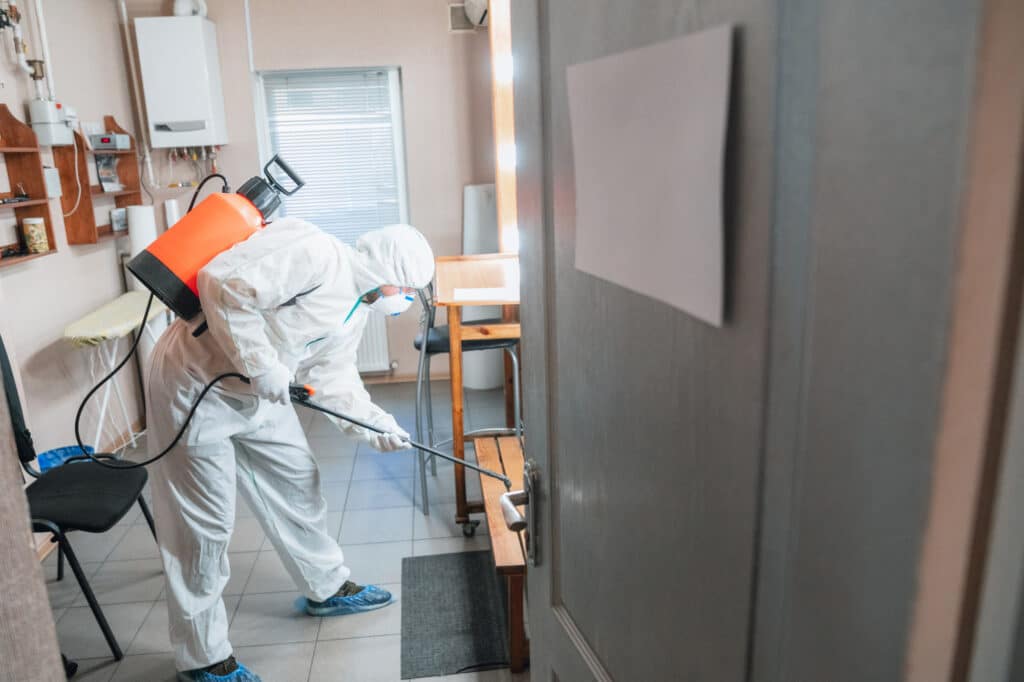SEO, or search engine optimization, is the process of improving the ranking of a website on search engines. Water damage restoration companies can use SEO to improve their visibility and bring in more customers. However, SEO is a complex field, and there are many things water damage restoration companies need to do in order to see results.
In this article, we will discuss 10 of the most important SEO tips for water damage restoration companies. By following these tips, you can improve your website’s ranking on search engines and get more traffic.
My Top 10 SEO Tips for Getting More Traffic to Your Restoration Company’s Website
- Optimizing Your Website’s Image Alt Text
- Image File Naming
- Outbound Links
- Content Length
- Page Loading Speed
- Content Recency
- Domain Authority
- Keyword Density
- Valuable Content
- Google My Business Optimization
#1: Valuable Content
If you want your website to rank well on search engines, you need to have high-quality content. This means writing articles that are interesting, informative and helpful. It also means making sure your website’s design is user-friendly and easy to navigate.
Creating valuable content is one of the most important things you can do for your website’s SEO. This is because search engines like Google use algorithms to determine which websites are the most relevant and useful for users. If your website has high-quality content, it is more likely to be shared and re-visited. Metrics like time on page and returning users all show that a website is producing content that people want to view.
As a water restoration company, there are a few things you can do to make sure your content is valuable:
- Write articles that are interesting and informative.
- Provide information that answers questions and solves problems.
- Use keyword-rich titles and descriptions to help users digest your content
- Include calls to action on your website so that users know what to do next.
#2: Optimizing Your Website’s Image Alt Text
One of the most important SEO tips for water damage restoration companies is to optimize your website’s image alt text. The alt text is the text that appears in place of an image if the image cannot be displayed. It is also used by search engines to understand what an image is about.
To optimize your website’s image alt text, you should include keywords that describe the image. For example, if you have an image of a water damage restoration technician working on a flooded home, you could use the alt text “water damage restoration technician” or “water damage in a flooded home.”
Including keywords in your image alt text can help search engines understand what your website is about and improve your website’s ranking.
While this can be a great place to include additional keywords, it’s important not to stuff keywords here. As they say, everything in moderation. Utilize a good keyword in your alt text if it feels natural but don’t stuff them unnecessarily.
#3: Image File Naming
Another important SEO tip for water damage restoration companies is to use descriptive file names for their images. When you upload an image to your website, the file name is automatically generated. However, a lot of times it’s just random characters or something unrelated to your keywords.
For example, if you have an image of a water damage restoration technician working on a flooded home, the file name might be something like “IMG_1234.jpg.”
Instead of using a generic file name, you should include keywords that describe the image. For example, you could use the file name “water-damage-restoration-technician.jpg.”
Using descriptive file names for your images can help search engines better understand what your website is about and improve your website’s ranking.
#4: Outbound Links
Outbound links are links from your website to another website. Adding outbound links to your website may not directly improve search ranking, but it helps Google understand your content better. It also shows relevance when you’re linking to products or services related to your content.
As a water damage restoration company, you could add outbound links to products or services that you offer on your website. For example, you could add a link to a supplier of one of your products.
Outbound links are a great way to network with relevant websites and show Google what your page is all about!
#5: Content Length
Content length is another important SEO factor. A common misconception is that shorter or longer content is better for SEO. However, this is not necessarily true.
While it’s important to keep your content concise and to the point, longer content can also rank better than shorter content. This is because longer content gives you a chance to include more keywords and can provide more value to readers.
With that said, when the goal of longer content is simply to hit a word length requirement versus actually providing valuable content, this can hurt your site.
At the end of the day, the length of content should be based on what helps the reader the most. When it comes to water damage restoration SEO, consider the question the user is asking and give them the answer with appropriate detail. This may be 400-600 words or a 5,000 word guide.
A good tip is to google your desired keyword idea and see what the top positions are doing. If the majority of the top ranked websites are all short or long articles, that tells you that Google likely sees this length of content as the most appropriate to help the user answer their query.
#6: Page Loading Speed
Page loading speed is a huge ranking factor and something you should always be thinking about. Google wants to provide the best user experience possible, and part of that is providing users with fast loading pages.
Some things you can do to improve your page loading speed include optimizing images, minifying code, using caching, and reducing redirects. If you’re using WordPress, there are a good selection of plugins that will help with this. I personally like WP Rocket for performance enhancements and Imagify for image optimization.
#7: Content Recency
Content recency is a ranking factor that refers to how recently your content was published. When you first publish an article, it will likely see a spike in traffic.
However, over time as new articles are published, your older articles will start to drop off in ranking without updates. This is why it’s important to keep your website’s content up-to-date.
One way to do this is by adding a blog to your website. You can then publish new articles on a regular basis which will help improve your overall traffic. Another way to keep your content fresh is by regularly updating your existing articles. This could be something as simple as adding new information or images.
#8: Domain Authority
Domain Authority (DA) is a metric created by Moz that predicts how well a website will rank on search engines. It’s based on factors like age, popularity, and size.
In theory, the higher your DA, the more likely you are to rank well on search engines. However, it’s important to keep in mind that DA is not a perfect metric. It’s just one factor that can influence your ranking.
Different tools use different terms for domain authority, but many of the factors involved remain the same.
That said, if you’re looking to increase your website’s authority, there are a few things you can do. These include:
- getting quality backlinks
- optimizing your website’s on-page SEO
- improving your overall website user experience
- targeting better keywords
#9: Keyword Density
Keyword density is the number of times a keyword appears on your web page divided by the total number of words on the page. For example, if a keyword appears 5 times on a web page with a total of 100 words, the keyword density would be 5%.
It’s important to keep your keyword density in mind when writing content. If you stuff your content with too many keywords, it will come across as spammy and could hurt your ranking.
That said, you also don’t want your keyword density to be too low. If a keyword appears only once or twice on a page, it may not exhibit enough relevance to rank highly in search engines. It’s critical that you add your keywords evenly throughout the content, and also be sure to include it in your headings (h1, h2 and typically h3 as well).
It’s also very important to use keyword variation. Don’t just stuff the same exact keyword everywhere. Instead, use different variations. For example, if your target keyword is “water damage restoration services”, you would also want to add similar concepts like “water damage restoration solutions.”
A good rule of thumb for water damage restoration SEO is to keep your keyword density between 1.5-3%.
#10: Google My Business Optimization
Google My Business (GMB) is a free listing that allows businesses to manage their online information on Google. This includes things like your business name, address, phone number, hours of operation, and category.
It’s important to have a GMB listing because it can help improve your ranking in local search results. GMB listings are one of the easiest ways to show up quickly for local searches. These results will show above the top organic searches in the Map Pack. Business details will also show on the right hand of search results.
GMB has an abundance of features as well. Users can message you in a chat, get directions, call, read posts and promotions and more all from your GMB listing.
When optimizing your GMB listing, there are a few things you can do:
- First, make sure your business information is accurate and up-to-date. This includes your business name, address, and phone number (NAP).
- It’s also important to include as much information as possible in your GMB listing. The more information you provide, the better. This includes things like your business hours, website URL, products and services, photos and videos, and more. This is your opportunity to include keywords and location information regarding your services.
- Add your service areas and/or address. Even if you don’t have a physical location, it’s still very important to set your service areas if you want to appear in relevant local searches.
- Finally, be sure to actively manage your GMB listing. This means responding to messages and reviews in a timely manner. You should also post regular updates and promotions.
By following these tips, you can optimize your GMB listing and you’ll likely start showing up in results much faster than with other methods of SEO.
In Summary – How to Get More Traffic as a Water Damage Restoration Company
By following these tips, you can optimize your website and improve your ranking in search engine results. This will help you get more traffic to your site and generate more leads for your business.
SEO is a complex and ever-changing field, but by staying up-to-date on the latest trends and best practices, you can ensure that your website is getting the visibility it deserves.
If you need help with your restoration company’s SEO, contact me today to discuss my local SEO services. I’m happy to help!


